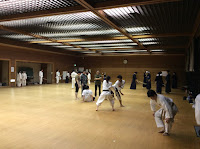 |
| Miyagi Chojun teaching Seiyunchin |
As with most Gojuryu history, the origins of Seiyunchin are hazy at best, though it seems the kata has long been known and practiced in Okinawa. It is pronounced in different ways depending on the various schools, including Seiyunchin, Seiunchin, and Seienchin. The former pronunciation was the one I heard most at Yoyogi Ryushinkan, though not the only one.
Moreover, different kanji can be used, so it is often written phonetically in the katakana script as セイユンチン. The most common characters used by Okinawan masters such as Eiichi Miyazato and Morio Higaonna are 制引戦, meaning "control pull fight.” These seem appropriate given the throwing and grappling techniques found in the kata, as well as Miyazato Sensei's Judo background.* Another set of kanji is 征遠鎮 and pronounced Seienchin, more commonly used in Shitoryu. This loosely translates as “attack far suppress.” More information on the history of this kata can be found here.
* See next post for further clarification on the kanji used in Gojuryu for this kata.
Moreover, different kanji can be used, so it is often written phonetically in the katakana script as セイユンチン. The most common characters used by Okinawan masters such as Eiichi Miyazato and Morio Higaonna are 制引戦, meaning "control pull fight.” These seem appropriate given the throwing and grappling techniques found in the kata, as well as Miyazato Sensei's Judo background.* Another set of kanji is 征遠鎮 and pronounced Seienchin, more commonly used in Shitoryu. This loosely translates as “attack far suppress.” More information on the history of this kata can be found here.
* See next post for further clarification on the kanji used in Gojuryu for this kata.































